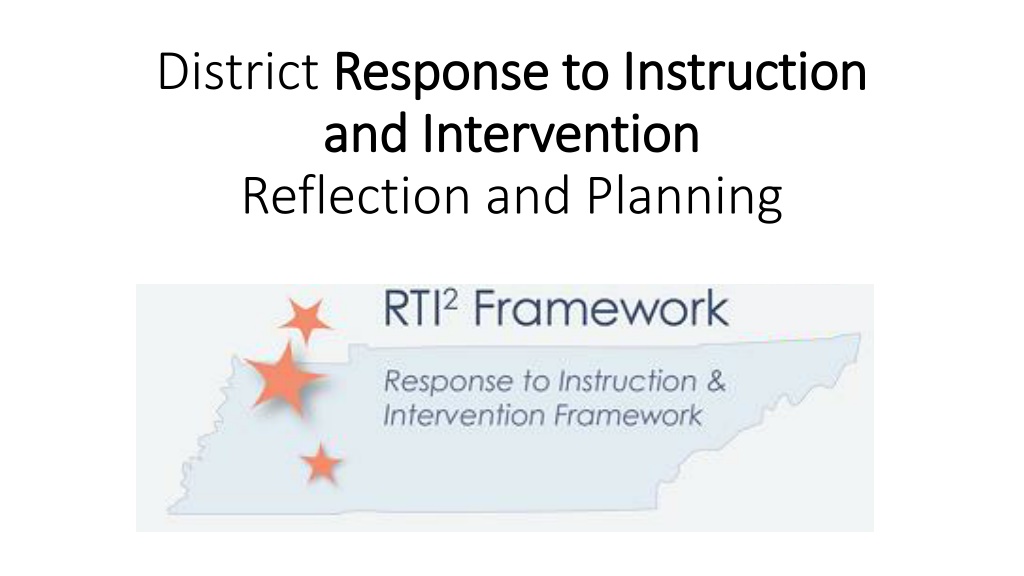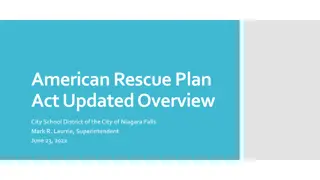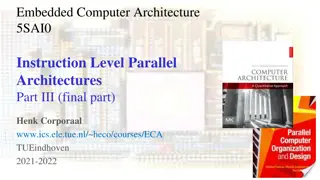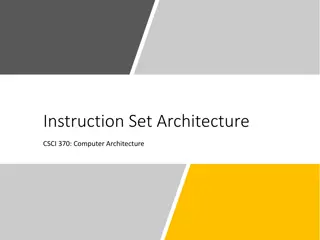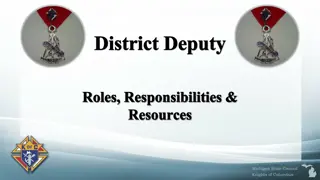District Response to Instruction and Intervention Planning
Explore the District's Response to Instruction and Intervention, including goals, guiding questions, materials, guiding principles, objectives, and norms for successful implementation. The focus is on reducing students scoring below basic, creating effective spaces for instruction, utilizing data, differentiating interventions, and ensuring fidelity in the RTI2 Framework. Emphasizing leadership, collaboration, prevention, early intervention, and assessment data usage, the plan aims to develop tailored action plans for district improvement.
Download Presentation

Please find below an Image/Link to download the presentation.
The content on the website is provided AS IS for your information and personal use only. It may not be sold, licensed, or shared on other websites without obtaining consent from the author. Download presentation by click this link. If you encounter any issues during the download, it is possible that the publisher has removed the file from their server.
E N D
Presentation Transcript
District Response to Instruction Response to Instruction and Intervention and Intervention Reflection and Planning
Our goal Our goal By 2017, the RTI2Framework will reduce the number of students scoring below basic on the NAEP. 2
Guiding Question Four:How do I create a space for skills instruction to occur regularly for all students at different grade levels and with different needs? Guiding Question One: How do you use data? What are your sources of data? What data do you use when? Guiding Question Three:How are interventions different than what happens during regular instruction? Guiding Question Two: How do you ensure that RTI2 is running with fidelity? 3
Material Walk Through Material Walk Through Next Steps Action Planning Toolkit Agenda (p. 3-4) Four Guided Question section tabs Discussion protocol Notes page Discussion Tool, SWOT, Guided Question Planning Resources (p. 15) Next Steps Action Planning documents tab 4
Our Our G Guiding Principles uiding Principles 1. Leadership at the state, district, and building level is essential for ensuring the success of ALL students throughout the RTI2 Framework 2. A culture of collaboration that is focused on student achievement, for both struggling and advancing students, should include educators, families and communities 3. RTI2 is a process focused on prevention and early intervention that uses assessment data for instruction, intervention and transitions between tiers 5
Objectives Develop/revise an RTI2 action plan with clear next steps that is tailored to district capacity and meets state requirements. Norms 1. Respect for diverse needs of district teams in whole group discussions. 2. Engage fully and avoid personal technology use. 3. Use planned agenda items fully and respect the air time of whole group to ensure agenda timeline is followed. 3. Transparent collaboration during district work time and whole group discussions. 4. Utilize work time effectively to clarify district needs and plan steps to move forward. 5. Parking Lot for unanswered questions and return answers sent through CORE office in one week. 6
The why of RTI The why of RTI2 2 Rucker-Stewart Middle School student Sumner County 7
Guiding Question Guiding Question Four: create a space for skills instruction to occur regularly for all students at different grade levels and with different needs? Four: How do I 8
Prioritizing the Prioritizing the WHAT WHAT of the additional time of the additional time Priorities based on student needs Tier II, III, and special education intervention Core Curriculum + 1st 2nd 3rd Standards remediation Skills deficit Intervention Enrichment Re-teaching support 9
Using the Time Inventory Protocol Using the Time Inventory Protocol (p.128) (p.128) Log instructional minutes by content area. Log non-instructional time by topic. Are there simple swaps to recommend? Creative solutions? Use other samples. 10
Using the Personnel Inventory Protocol Using the Personnel Inventory Protocol (p. 129) (p. 129) Which staff members fit where? Considerations in shifting personnel roles What are district resources to leverage? 11
Discussion Scenario Discussion Scenario Four Four 1. Turn to the discussion scenario on page 114 of your Action Planning Toolkit. 2. You have a sample middle school building schedule before RTI2 and a sample middle school building schedule after RTI2. 3. The scenario questions walk your team through an analysis of how the usage of time and staff changed in these sample schedules. 4. How could some of these changes work in your district with some of your buildings? 5. What ideas might be tweaked to fit your schools? 12
District Discussion Time District Discussion Time 1. Discussion Protocol (p. 123) analyze the existing data tools what are you using the data results for how the data drives decisions for different tiers of instruction 2. SWOT Protocol (p. 124) what are the strengths of using data where are your gaps how can you use your strengths to overcome your gaps what are threats to success 15 minutes End 13
SWOT Sharing SWOT Sharing 1. Count off at table. 2. Move to the Post It note that matches your number and share with others. 3. Return to district group to share experiences from other districts. 4. Prepare post it for shared. Strengths Weaknesses Opportunities Threats 14
Action Planning Action Planning (p. 125 and 144) 1. Resources Walk (p. 127) 20 minutes 2. Planning 3. A Focus on Key Messages and General Rules of Practice End 15
Points to Consider and Culminating Work Time Points to Consider and Culminating Work Time (p.143) (p.143) 1. First, review the key points to consider as these are areas of fidelity that a district needs to ensure. 2. Prioritize the issues from each of the four guided questions. 3. Begin to develop a cohesive next steps plan for RTI2 from a district perspective. 4. Review the roles, timelines, and statements of success to ensure that the overall plan is doable. 5. Do your key messages need to be shifted to align with your holistic needs? 6. Create an overarching timeline, responsibilities, and key messages planning document. 16
What is your biggest implementation strength? What are your key next steps? What are your district key messages that need to be clear? 17
RTI2 is a framework framework for high quality instruction high quality instruction for all all students ensuring ensuring equal access to the core curriculum curriculum through differentiated instruction and intervention intervention supports. core instruction 18
Contact Information Contact Information Suzanne Keefe, Director of Special Projects Suzanne.Keefe@tn.gov Lisa Coons, Deputy Director of Instructional Leadership Support Lisa.Coons@tn.gov Rti.questions@tn.gov 19
